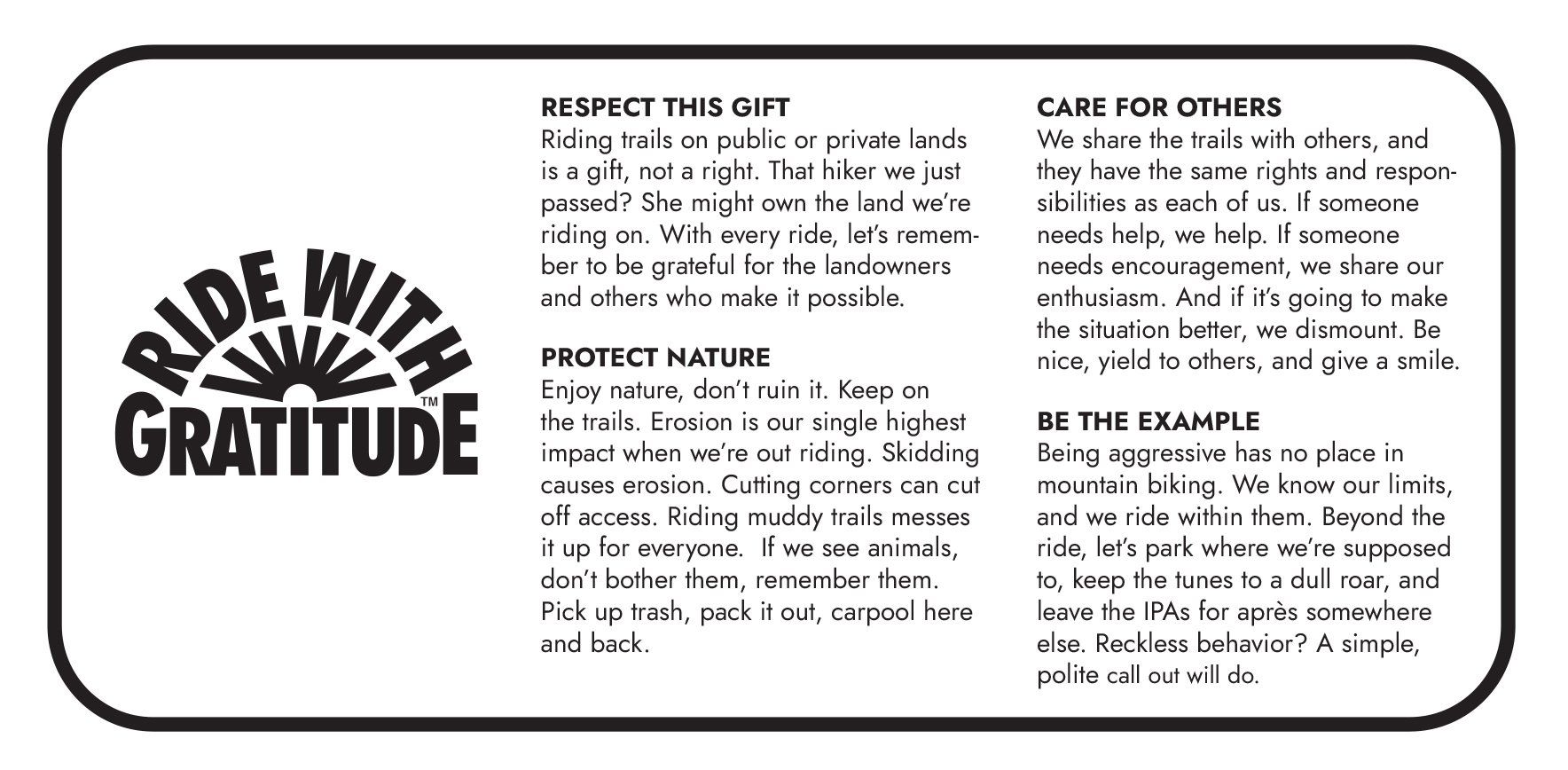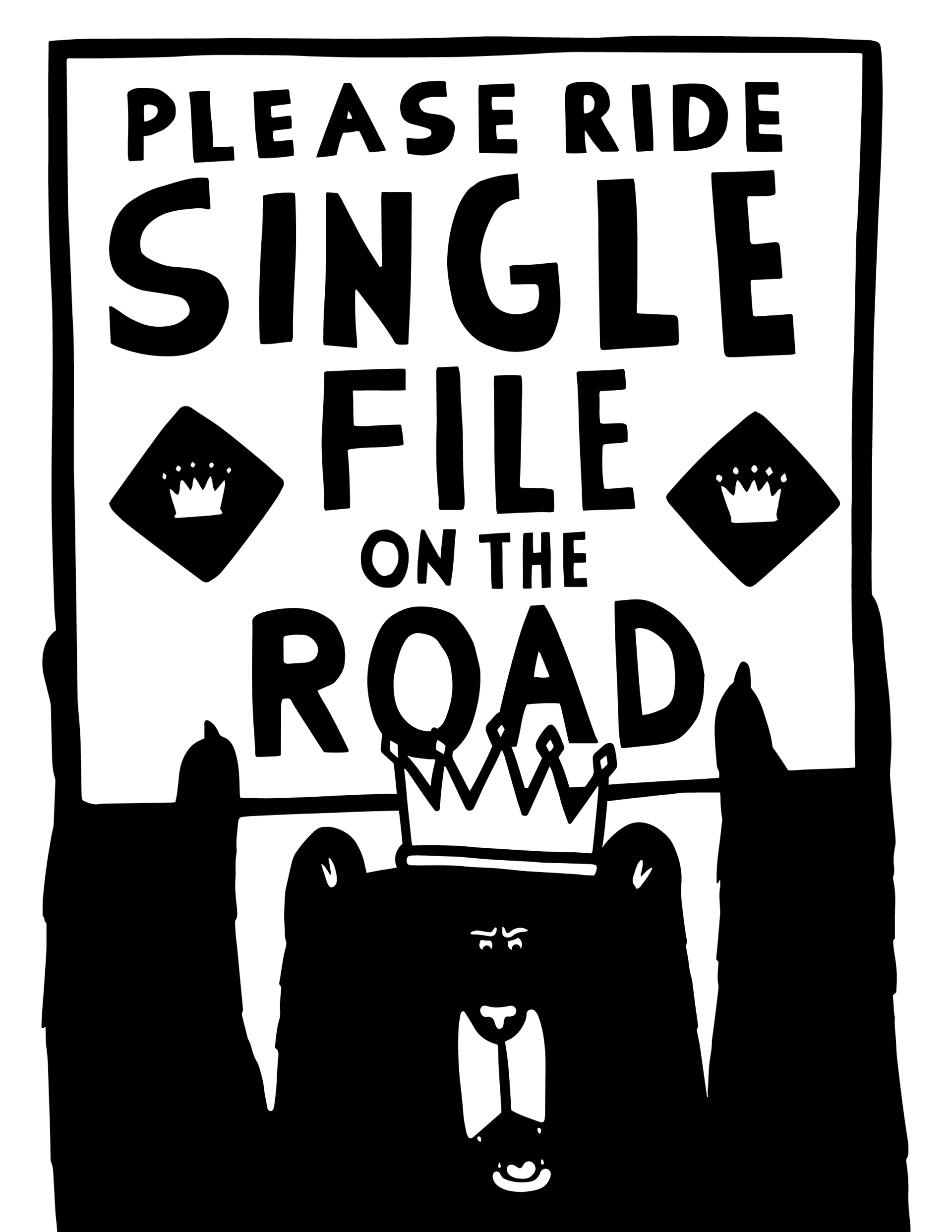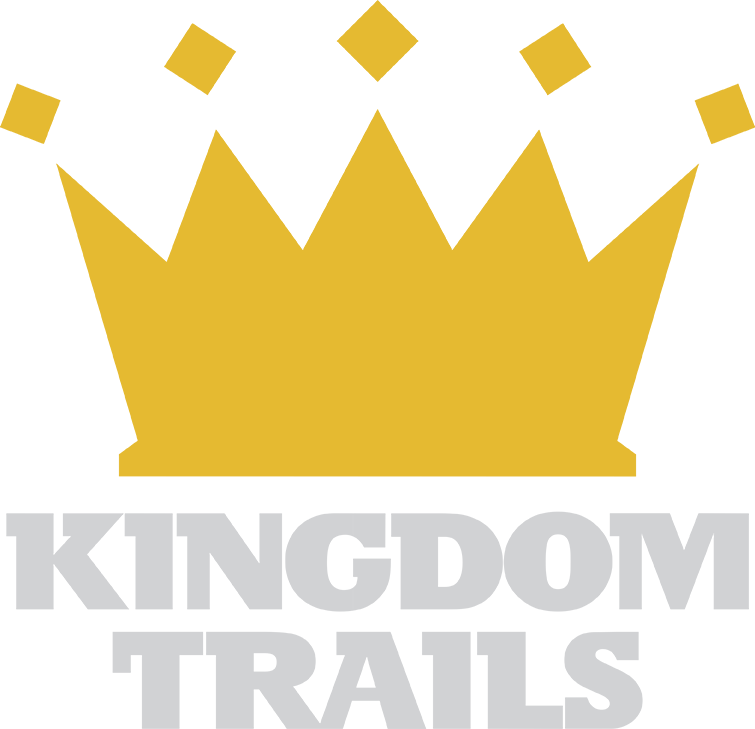


-
Ride With Gratitude
-
Rules of The Trail
- Purchase a KT Membership
- Stay on designated trails
- No overnight camping or fires
- Park only in designated KT parking lots.
- Leave No Trace.
- Helmets Required
- Riders yield to everybody, including each other.
- Communicate and stay in control.
- On the road, travel single file and ride to the right.
- Always stop for vehicles.
- No motorized vehicles.
- Dogs are ONLY allowed on Village trails. (Please clean up after your dog.)
- No horses on singletrack trails.
- Keep group sizes to ten people or less. If more, split into groups.
- No RV parking at the Inn at Mountain View Farm.
- No nighttime trail access at Moose Haven.
-
Code of Conduct
- Respect private property and homes.
- Follow all traffic rules and be aware of other traffic, i.e. cars, trucks and buses.
- Ride single file on the roads or trails.
- Do not congregate in the roads.
- Limit group numbers to 10 or less.
- Use public restrooms at designated locations.
- Do not wash bikes in streams or rivers.
- Everyone should yield first and then figure out how to pass each other safely keeping distance
-
e-bike/ eMTB FAQ's
What is KT’s eMTB Policy?
- Class 1 Pedal Assist eMTBs are allowed on Kingdom Trails for any rider, except where excluded per landowners' request as shown on the map https://www.kingdomtrails.org/trailmap
What class of eMTB can I ride at KT?
- You may only use a class 1 eMTB or electric assist aMTB. A Class 1 eMTB/ e-bike is defined as two wheeled cycles with fully operational pedals and an electric motor assist of no more than 750 watts (1 horsepower) and (i) are incapable of propelling the vehicle at a speed of more than twenty (20) miles per hour; and (ii) disengage or cease to function when the rider stops pedaling or the vehicle's brakes are applied.
Please see Burke Mountain Resort's Rules and Policies at Skiburke.com
-
Parking
- Only park and access the trails in KTA designated areas. You are not allowed to park or access the network from any other locations.
- If the parking lot is full you must go to another lot.
-
Dog Policy
No dogs, except on the Village Trail section of the network.
During the winter season, dogs are permitted on Dashney Nordic trails.
-
Group Size Policy
Maximim group size on trails is 10 people.
-
Allowable Use
- The trail network is for multi-use non-motorized recreation.
- Horses are allowed, with individual landowner permissions, on trails marked as doubletrack. Follow this link for information on how to interact with horses on the trail and road.
- Class 1 Pedal Assist eMTBs are allowed on Kingdom Trails for any rider. See eMTB FAQ's for more information.
-
Access
- Kingdom Trail Association membership allows access to the Kingdom Trails network. Purchase a KTA Membership online here.
- Park in designated Kingdom Trails parking locations only.
-
Trail Closings & Rain Policy
Trail closures and conditions will always be updated to the minute on our trail conditions page
- Trails open for the summer season as weather permits in May and close on October 31.
- Once the trail network is open for the summer season, due to well draining soils, sustainable trail-building and our trail maintenance capabilities, we rarely if ever, close the trails. If trails are closed, they will always be marked on our trail conditions page.
- The trail network is closed for the month of November and early December during VT Deer Hunting season.
- Winter network opens as soon as hunting season is over and conditions permit.
-
3rd Party Event Guidelines
-
Winter Season Opening Policy
The winter trail network may only open for the season after a substantial stretch of below freezing temperatures to allow the ground to thoroughly freeze AND after the end of the muzzleloader hunting season
The fatbike trails will open to fatbikes (tire 3.5 inches or wider) as long as the ground is frozen and can be ridden without causing damage to the trail surface.
- If there is no snow, regular mtb tires are allowed on open trails.
The groomed ski trails will open when the ground is frozen and we have received a sufficient amount, preferably 6-8” or more, of snow to groom and maintain.
The snowshoe and backcountry ski trails are open when the ground is frozen and snow coverage allows.
- If there is no snow, foot travel is allowed on open trails.
For up to the minute trail conditions and information on which trails are open or closed, visit our trail conditions page.
-
Winter Grooming Policies
During the winter season the trails will remain OPEN as long as surface conditions are safe and the ground is sufficiently frozen to accommodate ski, fatbike or snowshoe traffic without causing damage to the trail. Trail surface conditions and closures are always reported on the trail conditions page of our website.
KT utilizes customized weather forecasts provided by Nor’Easter Weather to make the most informed decisions on how and when to groom.
When there is a base and a significant amount of snowfall is forecasted, grooming begins after 2+ inches of accumulation and continues until the snowfall ends.
If there is low, or no existing base, this can affect the frequency of grooming. Our Crew will wait for a more significant accumulation of 6+ inches before they start grooming since thin conditions can lead to damaging the trails, like digging up dirt, or even being detrimental to our equipment. There is a balance in these scenarios when less is more, and the surface, as well as the snowpack, can remain more sustainable with less manipulation.
When grooming soft or slushy snow in warm temps, it is critical to find the window of time when the surface consistency is accessible for manipulation and our equipment is manageable, as snowmobiles are difficult to steer and drags can get bound up with heavy wet snow.
Icy conditions are also challenging as we operate without a tiller, the machinery used to break up ice. When conditions become icy, we will make sure to communicate through all avenues, the necessity for caution and recommend proper equipment such as studded tires and snowshoes with crampons. And if safety requires it, we will close trails.
POLICIES & FAQs



